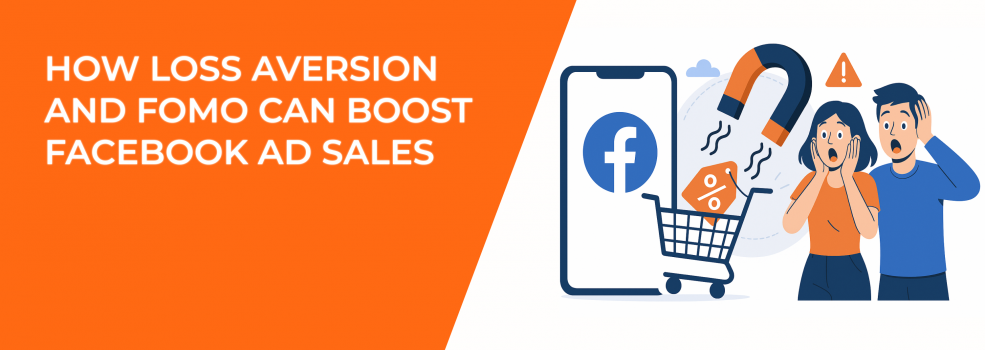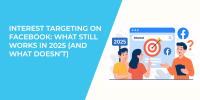Every day, users scroll through Facebook and Instagram feeds filled with discounts, promotions, and limited-time offers. But only a few ads actually make people stop, think, and take action.
Why?
Because the most effective ads don’t just share offers. They trigger emotions. And two of the most powerful emotional drivers for ad performance are loss aversion and FOMO (fear of missing out).
Used correctly, these principles can push hesitant users to click, convert, and buy. They don’t require a bigger budget — just sharper strategy and smarter copy.
Let’s explore how these psychological triggers can increase your Facebook ad sales and what practical steps you can take to use them.
What Is Loss Aversion — and How Does It Affect Buying Behavior?
Loss aversion is the idea that people would rather avoid a loss than achieve a gain. In simple terms, losing something feels worse than gaining something of equal value feels good.
In a marketing context, this principle shows up all the time — often without people realizing it.
Here’s how to apply it in your Facebook ads:
-
Frame your offer as a loss if ignored. Use language that focuses on what the customer stands to lose. For example: “Don’t miss your 30% discount — offer ends at midnight.” This creates tension and urgency, especially when tied to a deadline.
-
Set real deadlines and stick to them. When an ad says “ends tonight,” make sure it actually ends. People grow numb to false urgency.
-
Use countdown timers. Even a simple countdown in the ad creative can increase clicks. Timers reinforce urgency visually and make the loss feel more immediate.
-
Emphasize limited availability. Scarcity works. But it needs to feel real. Try phrases like: “Only 12 spots left”, “Limited to the first 100 buyers”, or “Last size in stock.”
People act faster when they fear losing access — not just when they see potential gain.
Using FOMO to Drive Action on Facebook and Instagram
Fear of missing out is a subtle but powerful motivator. It thrives on social cues — what others are doing, what’s trending, what people could be experiencing right now.
FOMO is especially effective on social platforms, where users constantly compare themselves to others and track what they might be missing.
To build FOMO into your ad campaigns:
-
Show what others are already doing. Mention how many people have bought, joined, or signed up. Examples: “Over 2,000 orders placed this week”, or “Thousands have already switched.”
-
Highlight exclusive access. People want what others can’t easily get. Use language like: “Private invite”, “Early access”, or “Members-only sale.”
-
Create time-limited experiences. Instead of permanent discounts, experiment with flash offers: “Today only”, “Ends in 6 hours”, or “Weekend-only event.”
-
Use real user content (when possible). Showcase what your community is doing with your product. User-generated content builds trust and amplifies the feeling of missing out.
FOMO works best when the benefit seems exciting and the opportunity feels scarce.
Strong emotional framing only works if your copy is well-structured — here’s a step-by-step guide to writing high-converting Facebook ad copy.
Targeting the Right Audience Is Critical
You can have the best message in the world — but if it reaches the wrong people, it won’t work.
To make the most of loss aversion and FOMO, deliver your ads to people who are already interested, active, and aligned with your offer.
Instead of relying solely on broad interest categories, experiment with building audiences around behavior and activity. People who actively engage with niche communities, comment on posts, or follow specific brands tend to convert at higher rates — especially when the message feels personal and time-sensitive.
Target smarter by:
-
Creating custom audiences based on website visits, video views, or social engagement.
-
Retargeting people who interacted with a previous campaign but didn’t convert.
-
Layering interests with behaviors to narrow your targeting without shrinking your reach too far.
Once your audience is dialed in, pair it with urgency-driven messaging. That’s where emotional triggers can outperform traditional calls to action.
Make Scarcity Feel Authentic
Consumers have seen every trick in the book. False urgency and fake scarcity backfire — they reduce trust and can even lower engagement over time.
If you use urgency, back it up with real limitations. If an offer ends in 24 hours, close it in 24 hours. If you only have 50 items, don’t restock mid-sale without explanation.
To maintain credibility while using scarcity:
-
Update ad creatives to reflect real-time stock or capacity.
-
Avoid overly aggressive language like “Going fast!” unless you have data to support it.
-
Be transparent about why something is limited. Example: “This style won’t be restocked due to material shortages.”
Scarcity drives clicks but only if your audience believes the window is real.
Emotional Triggers Work Best When Anchored in Clarity
It’s easy to get carried away with urgency and social proof, but clarity still matters. If your audience can’t understand the offer in seconds, they’ll scroll past.
Your message should be sharp, honest, and focused on what action to take and why it matters right now.
Tips for writing emotionally-driven Facebook ad copy:
-
Lead with the pain or urgency, not the product features.
-
Be specific about deadlines, quantities, or community size.
-
Use natural, conversational language — avoid clichés or overly formal phrasing.
-
Always include a clear call to action, especially in time-sensitive ads.
Your goal isn’t just to inform — it’s to make people feel like they need to act today.
To understand how emotional triggers shape engagement, explore this breakdown of Facebook ad psychology for more insight on attention-grabbing tactics.
Test, Learn, and Adapt
No two audiences react the same way. Some respond better to fear of missing out. Others are more sensitive to losing a deal. The only way to know is to test variations of your messaging and monitor performance closely.
Try running split tests that compare:
-
Gain-focused vs. loss-focused copy,
-
Generic urgency vs. personalized urgency,
-
Broad audiences vs. niche behavioral segments.
Watch metrics like CTR, CPC, and conversion rates. Over time, you’ll learn which triggers work best for your specific offer, product, and market.
Split testing is crucial to refining emotional messaging — this list of Facebook ad testing strategies outlines exactly what to experiment with first.
Conclusion
People buy emotionally, then justify logically. Loss aversion and FOMO tap into that emotional layer — and when combined with thoughtful targeting and honest urgency, they can significantly increase your Facebook and Instagram ad performance.
Instead of just promoting discounts, start creating moments that feel exclusive, limited, and important. Show your audience what they stand to lose — and what others are already gaining.
The next time you build a campaign, ask yourself: what would make someone feel they can’t afford to wait? Then put that answer at the heart of your ad.

